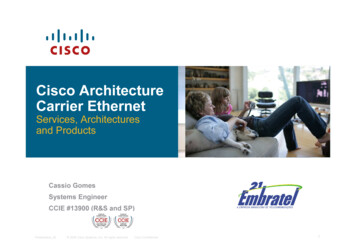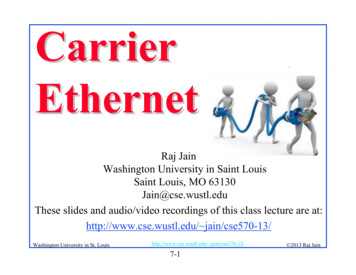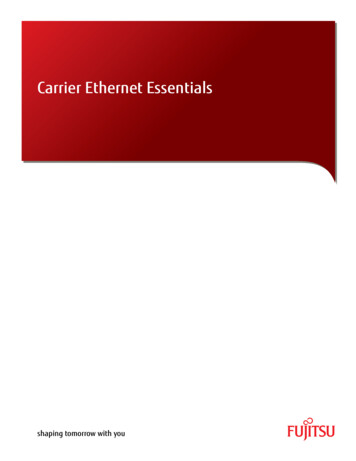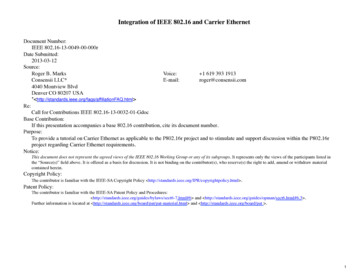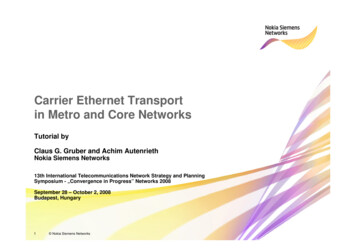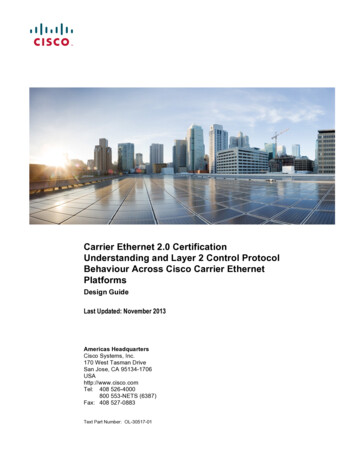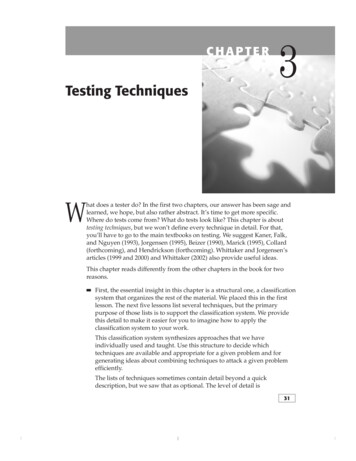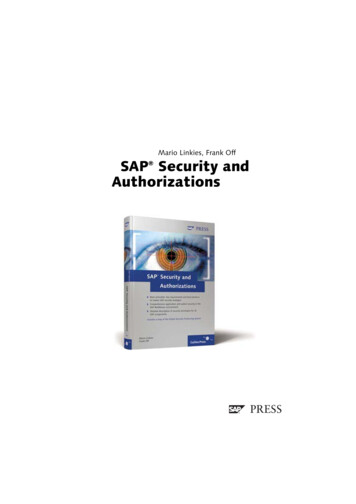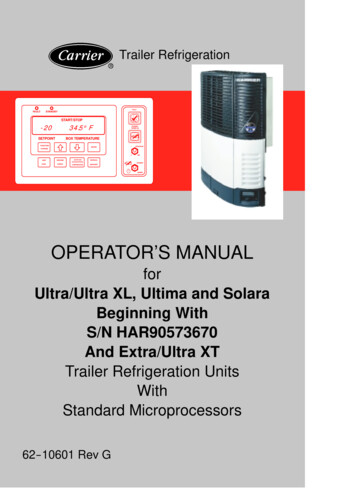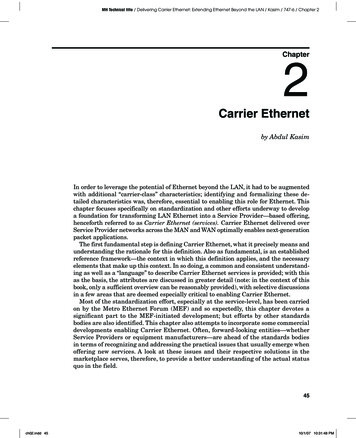
Transcription
MH Technical title / Delivering Carrier Ethernet: Extending Ethernet Beyond the LAN / Kasim / 747-6 / Chapter 2Chapter2Carrier Ethernetby Abdul KasimIn order to leverage the potential of Ethernet beyond the LAN, it had to be augmentedwith additional “carrier-class” characteristics; identifying and formalizing these detailed characteristics was, therefore, essential to enabling this role for Ethernet. Thischapter focuses specifically on standardization and other efforts underway to developa foundation for transforming LAN Ethernet into a Service Provider—based offering,henceforth referred to as Carrier Ethernet (services). Carrier Ethernet delivered overService Provider networks across the MAN and WAN optimally enables next-generationpacket applications.The first fundamental step is defining Carrier Ethernet, what it precisely means andunderstanding the rationale for this definition. Also as fundamental, is an establishedreference framework—the context in which this definition applies, and the necessaryelements that make up this context. In so doing, a common and consistent understanding as well as a “language” to describe Carrier Ethernet services is provided; with thisas the basis, the attributes are discussed in greater detail (note: in the context of thisbook, only a sufficient overview can be reasonably provided), with selective discussionsin a few areas that are deemed especially critical to enabling Carrier Ethernet.Most of the standardization effort, especially at the service-level, has been carriedon by the Metro Ethernet Forum (MEF) and so expectedly, this chapter devotes asignificant part to the MEF-initiated development; but efforts by other standardsbodies are also identified. This chapter also attempts to incorporate some commercialdevelopments enabling Carrier Ethernet. Often, forward-looking entities—whetherService Providers or equipment manufacturers—are ahead of the standards bodiesin terms of recognizing and addressing the practical issues that usually emerge whenoffering new services. A look at these issues and their respective solutions in themarketplace serves, therefore, to provide a better understanding of the actual statusquo in the field.45ch02.indd 4510/1/07 10:31:48 PM
MH Technical title / Delivering Carrier Ethernet: Extending Ethernet Beyond the LAN / Kasim / 747-6 /Chapter 246Chapter 2Defining Carrier EthernetAlthough numerous efforts, both informal and formal (standards-based), have beenundertaken to make Ethernet more viable as a technology and service beyond theLAN, the MEF has been instrumental in initiating a substantial formal effort to define Carrier Ethernet services (delivered by Service Providers). This definition was aprerequisite to developing a common understanding and a common objective in thedelivery of such services.Among the first steps undertaken was to define more precisely what such Ethernetservices would entail, since, as noted in the previous chapter and repeated in Table 2.1,there are fundamental differences in providing Ethernet in the Service Provider network(broadly referred to as Carrier Ethernet) as opposed to providing Ethernet in the LAN.The context in which Carrier Ethernet services are defined is, therefore, the ServiceProvider networks and the several types of services already being delivered over theseTABLE 2.1Ethernet in the LAN Versus Ethernet in a Service Provide Network (Spanning the MAN and WAN)DimensionLocal Area NetworkService Provider NetworkGeography/ReachUsually less than 1–2 km; deployed inbuilding(s) and small campuses10–100 km and longer; deployed ina metro area or even across distantmetro areasService ProviderEnterprise (IT group); implemented by Service Provider (Carrier typically);internal IT group.services offered commercially for aninitial and recurring costUser of serviceEnterpriseEnterpriseNumber of end users/points (Scale)In the tens/hundredsThousands or tens/hundreds ofthousandsBandwidth10M/100M/1000M1M and greater—up to 10,000M;usually in granular increments of 1MAggregation requiredServices offered (scope)Enterprise data applicationsVoice / TDM and data connectivityapplications such as Internet Access,intra-metro connectivityDelivery of Ethernet servicesOver coax (CAT 5) and fiber;Best effortOver a host of media, incumbenttransport technologies, and with anassociated service-level agreement(SLA)Tolerance to failures (resiliency)Generally reasonable because network Very low tolerance because failuresis usually intra-enterprise and over a usually have a larger impact—oftensmaller physical area so failures canon revenues and competitivenessbe addressed relatively quicklyManageabilityManageability possible with fairlysimple tools given fewer numberof users and applications within asmaller physical area (typically abuilding or campus) and the relativelyhigher tolerance to failure issuesch02.indd 46Scale and scope of the ServiceProvider network in terms of thenumber of users and the geographicalfootprint introduces significantcomplexity necessitating sophisticatedmanagement tools and capabilities10/1/07 10:31:48 PM
MH Technical title / Delivering Carrier Ethernet: Extending Ethernet Beyond the LAN / Kasim / 747-6 /Chapter 2Carrier Ethernet47networks. In fact, Carrier Ethernet essentially encompasses the deterministic and otherservice delivery aspects for standardized Ethernet services. This point is key because ithighlights the focus on standardized Ethernet services and the specific characteristicsof such services and not necessarily the underlying transport infrastructure itself. Sowhat is Carrier Ethernet?Carrier Ethernet: A Formal DefinitionThe MEF1 has defined Carrier Ethernet as the “ubiquitous, standardized, Carrier-classservice defined by five attributes that distinguish Carrier Ethernet from the familiarLAN based Ethernet.” As depicted in Figure 2.1, these five attributes, in no particularorder, are1. Standardized services2. Scalability3. Reliability4. Quality of Service (QoS)5. Service managementCarrier Ethernet essentially augments traditional Ethernet, optimized for LAN deployment, with Carrier-class capabilities which make it optimal for deployment in ServiceProvider Access/Metro Area Networks and beyond, to the Wide Area Network. And conversely, from an end-user (enterprise) standpoint, Carrier Ethernet is a service that notonly provides a standard Ethernet (or for that matter, a standardized non-Ethernet2)handoff but also provides the robustness, deterministic performance, management, andflexibility expected of Carrier-class services.Fundamental to both Carrier Ethernet and LAN Ethernet is the fact that data iscarried in an Ethernet frame. What this means is, in effect, an Ethernet frame originating at a device in the LAN, now continues to traverse across one or more ServiceProvider networks,3 largely unaltered, and terminates at a device in a remote LAN.One way to look at this transformation is that it essentially creates one larger Ethernet,spanning LANs, MANs, and may be even the WAN, albeit delivered as a service to thecustomer. This transformation is shown in Figure 2.2, courtesy of the MEF, and illustrates the remarkable potential of Carrier Ethernet. The terms UNI and NNI in thefigure denote standardized interface hand-offs between the enterprise customer and1MEF is the preeminent nonprofit industry body focused solely on enabling Carrier Ethernet. The “Metro”reference in MEF is now a misnomer, however, and does not accurately reflect its charter and focus, whichhas long extended beyond the metro.2Because it can, as will be seen later, also support non-Ethernet services (albeit over an Ethernet layer).3The Service Provider networks could encompass both the MAN and the WAN.ch02.indd 4710/1/07 10:31:49 PM
MH Technical title / Delivering Carrier Ethernet: Extending Ethernet Beyond the LAN / Kasim / 747-6 /Chapter 248Chapter 2StandardizedServicesScalabilityQuality tyFigure 2.1 Attributes of Carrier Ethernet (Source: rEthernetAccessCarrierEthernetInternetEthernet Services “Eth” LayerUNISubscriberSiteSubscriberSiteService Provider 1Metro EthernetNetworkE-NNIService Provider 2Metro re 2.2 Carrier Ethernet spanning Access, Metro, and Wide Area Networks (Source: MEF)ch02.indd 4810/1/07 10:31:50 PM
MH Technical title / Delivering Carrier Ethernet: Extending Ethernet Beyond the LAN / Kasim / 747-6 /Chapter 2Carrier Ethernet49the Service Provider network and between Service Providers (or Network Operators4),whose infrastructure is used to deliver the service, respectively, and are explained inmore detail later in this chapter.The Ethernet frame(s) may be transported as is, either natively and directly over aphysical media or encapsulated and delivered over a variety of overlay networks builtusing different technologies. Each of these very different networking technology solutions, however, delivers5 Carrier Ethernet services. It is critical to understand that theCarrier Ethernet attributes often manifest only partially in commercial solutions todaybecause they exist at the network/transport/physical layers as opposed to the servicelayer6. This will become clear in rest of the Part II when the various commercial solutions currently employed to deliver Carrier Ethernet are discussed.The focus in this book is primarily on delivering Carrier Ethernet services;the network and transport delivery infrastructure—the Carrier Ethernet solutions,provide the carrier-class attributes that enable commercial Carrier Ethernet services.Often, the term ‘Carrier Ethernet’ is interchangeably used to refer to both the Ethernetservices and the underpinning enabling solution infrastructure.NOTEThe Carrier-class attributes are delivered differently by the various network solutions(for example, how reliability is offered in one solution versus another). This is largely aresult of their respective geneses and subsequent evolution. It is important to also notethat some of the Carrier Ethernet attributes in a solution existed pre-Carrier Ethernet(albeit at the transport layer and not at the service layer) and were, in fact, initial drivers for the use of respective solution. For example, SONET offered impressive resiliencyto any failures in the fiber and/or equipment deployed in a ring topology, so it was adopted to support mission-critical voice services that required stringent SLAs.Each of the Carrier Ethernet solutions and its respective evolution toward optimizing delivery in Service Provider networks is discussed in a fair amount of detail inPart II of the book.Carrier Ethernet: The AttributesThe five attributes that define Carrier Ethernet essentially provide the additional capabilities necessary to use Ethernet in much the same way as the other precedingservice provider technologies such as ATM and Frame Relay.7 Each of these attributesis elaborated upon and its rationale highlighted in the sections that follow.4A Network Operator is distinguished from a Service Provider by the fact that the former’s infrastructureis employed in the delivery of Carrier Ethernet services; however, the service itself is commercially offeredto the customers (usually on a subscription basis) by the Service Provider. Service Provider often leaseinfrastructure from network operators to deliver services.5More accurately, as will be evident in Part II, the solutions strive to offer the attributes of Carrier Ethernet.6Because at these lower layers inherently address only a subset of the higher-level service.7Especially helpful today because Ethernet is largely being used as a substitute for Frame Relay and ATM.ch02.indd 4910/1/07 10:31:50 PM
MH Technical title / Delivering Carrier Ethernet: Extending Ethernet Beyond the LAN / Kasim / 747-6 /Chapter 250Chapter 2This attribute essentially enables a Service Provider to delivera host of both Packet and traditional TDM (see chapter 10 for more information onTDM) multi-point services in an efficient and deterministic manner over standardizedequipment platforms. These services underpin the multitude of customer applicationsthat are emerging across voice, data, and video. Specific components that define thisattribute comprehensively are defined next.Standardized Services Ubiquity Carrier Ethernet enables ubiquitous Ethernet services provided viastandardized equipment, independent of the underlying media and transport infrastructure. This is a critical prerequisite to extending Ethernet’s appeal globally(similar to LAN Ethernet).Ethernet Services Carrier Ethernet supports two types of services: Point-toPoint (also referred to as Ethernet Line or E-LINE) and multipoint-to-multipointEthernet LAN (referred to as E-LAN) Ethernet services. These services are discussed in greater detail later in the chapter and are expected to provide the basisfor all Ethernet services.Circuit Emulation Services (CES) Carrier Ethernet supports not onlyEthernet-based services delivered across different transport technologies but alsoother (TDM) services transported over Carrier Ethernet itself. As noted previously, TDM services still remain an overwhelming contributor to Service Providerrevenues and realistically need to be supported (and delivered over a convergedEthernet-based infrastructure). TDM-based voice applications especially need tobe accommodated and characteristics of such applications such as synchronizationand signaling need to be emulated.Granularity and Quality of Services (QoS) The services supported by CarrierEthernet provide a wide choice and granularity of bandwidth and quality of serviceoptions. This flexibility is vital in Service Provider networks with its multitudeof end users, each with slightly different application requirements and, typically,operating equipment from multiple vendors. QoS capability is crucial to enforcingthe deterministic behavior of Carrier Ethernet.Converged transport Supports convergence of voice, data, and video servicesover a unified (Ethernet) transport and greatly simplifies the delivery, management, and addition of such services. Basically, all enterprise services and applications are now supported over a single Ethernet “pipe”.One fundamental difference between a LAN and a Service Provider network8 is scale. In a Service Provider network, there are usually a hundredfold moreend users and as a consequence, exponentially more connections for Ethernet-basedScalability8ch02.indd 50Or multiple Service Provider or Network Operator networks, since several such entities could be involved inthe delivery of an Ethernet service. A Network Operator owns the delivery infrastructure but may or maynot be the one offering a service (or the Service Provider).10/1/07 10:31:50 PM
MH Technical title / Delivering Carrier Ethernet: Extending Ethernet Beyond the LAN / Kasim / 747-6 /Chapter 2Carrier Ethernet51applications simply because it covers a larger geographic area. Carrier Ethernet solutions, therefore, scale across several dimensions simultaneously: Users/endpoints A Service Provider network supports hundreds of thousandsof endpoints and millions of Ethernet users in an optimal fashion. Specifically, itsupports the delivery of millions of Ethernet services with an appropriate level ofperformance or QoS.Geographical reach The services delivered can span access, metros, and beyond to encompass very large geographical distances and over a variety of infrastructures including Ethernet, WiFi, WiMax, TDM, SONET, and so on. As notedpreviously, the reach of such services can be augmented by employing multipleService Providers’ adjacent networks.Applications Current and emerging applications supporting a host of business,information, and entertainment applications and benefiting from the convergenceof voice, data, and video. The landscape or breadth of application support is a vitaldriver for Carrier Ethernet.Bandwidth Bandwidth scales from 1M to 10G in granular increments of 1M,enabling a much more palatable solution to both the end user and Service Providerbecause end users only have to “pay for what is required” and Service Providerswould possibly receive higher revenues.As these dimensions scale collectively, they make for a formidable problem to deliver,isolate, troubleshoot, and in general, manage thousands of users and hundreds of thousands of services in a robust manner.As Carrier Ethernet services are expected to support mission-critical applications on a wide scale, the ability to detect quickly and remotely any failures that may arisein the physical infrastructure or in the Ethernet services layer underlying these applications is essential. Specifically, the following aspects are addressed by Carrier Ethernet.Reliability ch02.indd 51Service Resiliency The impact of failures is localized and will not affect othercustomers and/or applications; Correlation among multiple errors will be quicklyidentified. Further, the process of troubleshooting and recovery from failures willbe rapid and employ tools that will minimize operational expenditures for theService Provider and any adverse impact on the end users.Protection Carrier Ethernet services provide an end-to-end service-level protection that encompasses protection against any failures in the underlying infrastructure employed in the delivery of the services. This means protection againstfailures in the end-to-end “path” of the service, as well as against any underlyingphysical link and node equipment failures.Restoration Carrier Ethernet provides similar or better recovery than SONET.The benchmark for resiliency in Service Provider networks has long been the10/1/07 10:31:51 PM
MH Technical title / Delivering Carrier Ethernet: Extending Ethernet Beyond the LAN / Kasim / 747-6 /Chapter 252Chapter 2SONET sub-50 ms service restoration to support circuit-switched voice networks.As latency-sensitive voice and video applications are deployed over a CarrierEthernet infrastructure, this SONET-like resiliency is a critical prerequisite.Techniques such as Spanning Tree Protocol (STP) and its variants, while feasiblein the LAN, are simply not acceptable in large Service Provider networks becausedepending on the size and complexity of the network, recovery of failures employing these techniques takes in the range of several seconds to even minutes. CarrierEthernet supports a host of latency-sensitive applications that are often criticalto an enterprise (for instance, regular telephony services), and consequently offersbetter fault-tolerant and recovery mechanisms.Providing Quality of Service (QoS) is necessary for Carrier Ethernetto be embraced as a substitute to ATM and Frame Relay and ultimately as a convergedmechanism to deliver all services. QoS essentially conforms to a predefined level of performance expected by an application. As Carrier Ethernet supports delivery of criticalenterprise applications that are commonly expected to adhere to certain performancelevels, this QoS capability becomes essential.The challenge to a Service Provider is significant given the fact that it has to simultaneously support individual QoS to typically thousands of applications and end users,using a limited set of resources (bandwidth, switching, and so on) whose availabilityvaries with time.Carrier Ethernet services providing QoS, encompass the following:Quality of Service Performance Service Level Agreement (SLA) There is the capability to provide the stringent end-to-end9 SLAs necessary to provide a host of critical voice,video, and data services over a converged Ethernet infrastructure. Such SLAs areessential, and end users often demand them since they are already accustomed tosuch an assurance using the ATM, Frame Relay, or Private Line services, and it isonly natural for them to expect the same of Ethernet services that support similarand next-generation applications.SLA parameters A set of con
Carrier Ethernet 49 MH Technical title / Delivering Carrier Ethernet: Extending Ethernet Beyond the LAN / Kasim / 747-6 /Chapter 2 the Service Provider network and between Service Providers (or Network Operators4), whose infrastructure is used t
